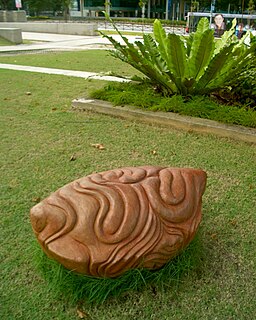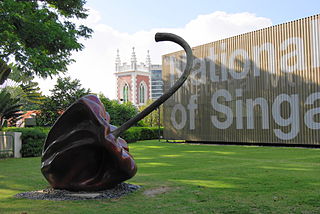
LASALLE College of the Arts is a publicly-funded post-secondary arts institution, and a soon-to-be University of the Arts by 2023 in alliance with Nanyang Academy of Fine Arts in Singapore.
LGBT art in Singapore, or queer art in Singapore, broadly refers to modern and contemporary visual art practices that draw on lesbian, gay, bisexual, and transgender+ imagery and themes, addressing topics such as LGBT rights, history and culture in Singapore. Such queer art practices are often by Singaporean or Singapore-based visual artists and curators who identify as LGBT+ or queer.

The Singapore Art Museum is an art museum located in the Downtown Core district of Singapore. Formerly a 19th-century Catholic school, it is the first fully dedicated contemporary visual arts museum in Singapore with one of the world’s most important collections by local, Southeast and East Asian artists. It collaborates with international art museums to co-curate contemporary art exhibitions.

The Singapore Biennale is a large-scale biennial contemporary art exhibition in Singapore, serving as the country’s major platform for international dialogue in contemporary art. It seeks to present and reflect the vigour of artistic practices in Singapore and Southeast Asia within a global context, fostering collaboration and engagement between artists, arts organisations, and the international arts community.
Donna Ong is a Singaporean contemporary artist. She is known for her installation works, which often feature environments created with assemblages, found objects, and sculpture. Her practice draws upon notions of botany, landscaping, and representations of nature in both European and Chinese art.
Group 90 is an informal arts group in Singapore, committed to the study and interpretation, and promotion of the human nudity as an art form. It was founded the late Brother Joseph McNally, along with founding members S. Namasivayam, Chia Wai Hon and Sim Tong Khern, who subscribe to the European art tradition of using the human body in developing artistic mastery in depicting form, perceptual acuity and fluency in drawing.
Tang Da Wu is a Singaporean artist who works in a variety of media, including drawing, painting, sculpture, installation art and performance art. Educated at Birmingham Polytechnic and Goldsmiths' College, University of London, Tang gave his first solo exhibition, consisting of drawings and paintings, in 1970 at the Singapore Chinese Chamber of Commerce and Industry. He began engaging in performance art upon returning to Singapore in 1979 following his undergraduate studies.

Han Sai Por is a Singaporean sculptor. A graduate of the Nanyang Academy of Fine Arts (NAFA), East Ham College of Art, Wolverhampton College of Art and Lincoln University, New Zealand, she worked as a teacher and later as a part-time lecturer at NAFA, the LASALLE-SIA College of the Arts, and the National Institute of Education, Nanyang Technological University, before becoming a full-time artist in 1997.
S. Chandrasekaran is a Singaporean contemporary artist known for his pioneering work in performance art in 1980s Singapore. He has held executive positions as Head of School at the Nanyang Academy of Fine Arts and LASALLE College of Arts.
Jantsankhorol Erdenebayar, also known as Jantsa, is a Mongolian multidisciplinary artist based in Los Angeles, California.

The 5th Passage Artists Limited, commonly known as 5th Passage or 5th Passage Artists, was an artist-run initiative and contemporary art space in Singapore from 1991 to 1994. As a registered, artist-led non-profit organisation, it was one of the earliest of its kind for early-1990s Singapore, with its initial space located at Parkway Parade, a shopping centre in the east of the city. The "meteoric existence" of 5th Passage has been noted alongside other art collectives and alternative spaces existing in 1990s Singapore, such as The Artists Village, The Substation, Plastique Kinetic Worms, and Trimurti.

Juliana Yasin was a Singaporean contemporary artist and curator whose practice spanned painting, installation, video, and performance art. Her works examined notions of identity, subjectivity, and community practices. Pedagogy and research further complemented her artistic practice, with Juliana having taught fine art at Kolej Bandar Utama in Kuala Lumpur and worked as a Singapore-based researcher for the Asia Art Archive, Hong Kong.

Suzann Victor is a Singaporean contemporary artist based in Australia whose practice spans installation, painting, and performance art. Victor is most known for her public artworks and installations that examine ideas of disembodiment, the postcolonial, and the environmental in response to space, context and architecture.
Shubigi Rao is a Mumbai-born Singaporean contemporary artist and writer known for her long-term, multidisciplinary projects and installation works that often use books, etchings, drawings, video, and archives. Her interests include archaeology, libraries, neuroscience, histories and lies, literature and violence, and natural history. Rao has exhibited internationally, presenting work at the 10th Taipei Biennial in 2016, the 3rd Pune Biennale in 2017, the 2nd Singapore Biennale in 2008, as well as the 4th Kochi-Muziris Biennale in 2018.
Ming Wong is a Singaporean contemporary artist who lives and works in Berlin, known for his re-interpretations of iconic films and performances from world cinema in his video installations, often featuring "miscastings" of himself in roles of varied identities.
Lim Tzay Chuen is a Singaporean contemporary artist known for his conceptual works that involve designing or constructing subtle interventions within systems, leading viewers to re-evaluate their perceptions and assumptions of social, economic, cultural and political processes.
Thiagarajan Kanaga Sabapathy, better known as T.K. Sabapathy, is Singapore's leading art historian, curator, and critic. Sabapathy has written, researched, documented, and supported contemporary visual art in Singapore and Malaysia for four decades. He has held positions at the National University of Singapore, Nanyang Technological Institution, and National Institute of Education as a lecturer of art history. Sabapathy further established and headed pioneering art research facilities in Singapore, such as the Contemporary Asian Art Centre (2001–2004) and subsequently, Asia Contemporary (2015–).

The visual art of Singapore, or Singaporean art, refers to all forms of visual art in or associated with Singapore from its history to present. Its history ranges from the beginnings of Ancient Singapore, possibly from the 10th century AD, to the present-day country. The history of Singaporean art includes the indigenous artistic traditions of the Malay Archipelago and with the arrival of the colonial period, the diverse visual practices of itinerant artists and migrants from China, the Indian subcontinent, and Europe, such as portraiture, landscapes, sculpture, printmaking, and natural history drawings. Post-World War II saw the emergence of practices such as Nanyang style paintings, social realist art, abstract art, and photography. The contemporary art practices of post-independence Singapore includes, for instance, performance art, conceptual art, installation art, video art, sound art, and new media art.

Kumari Nahappan is a Malaysian-born Singaporean contemporary artist best known for her large-scale public sculptures that often depict natural subjects such as fruit, seeds, and spices. Aside from sculpture and public art, Nahappan's interdisciplinary practice also spans installation and abstract painting.








